In Wales, It's Back to the Old Family Castle
By Stephen Brookes • The Washington Post • September 29, 2016
It’s early on a crisp, clear morning in July — hours before the first tourists will start to arrive — and Dame Emily Naper is walking through the ruins of her old ancestral castle, thinking about butterflies.
“Manorbier is a magical place, the most romantic castle in the world,” she says of this picturesque 12th Century manor on the rugged coast of Wales, which she inherited three years ago. “I collected butterflies and wildflowers here as a girl, and I want to keep it natural. It’s better for the imagination, don’t you think?”
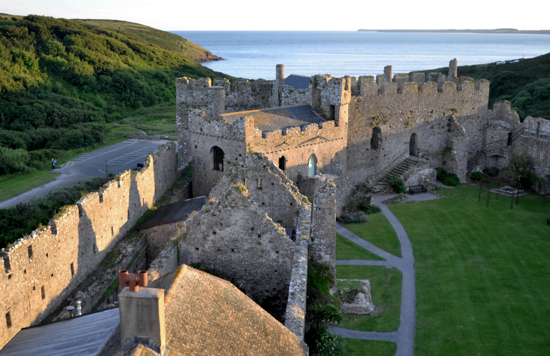
On this gorgeous morning, with the sun turning the high stone battlements to gold over our heads, it’s impossible to disagree. There may be, in fact, few medieval ruins in the world as unspoiled and naturally beautiful as Manorbier Castle. Set on a remote ridge over a small bay, this once-lavish estate has weathered the past nine centuries with remarkable grace, and everywhere you turn are the ruins of a vanished world — a kitchen fireplace large enough to roast an ox, limestone floors worn smooth with time, narrow staircases spiraling up through battle-scarred towers.
It feels forgotten and almost dreamlike here, as if we’d stumbled into a place undisturbed for centuries. And when Naper pushes open a postern door to the outside, a landscape appears that nearly takes my breath away: meadows of wildflowers sweeping down to the glittering sea, with the cliffs of the rugged Welsh coastline stretching off into the distance.
“I may never leave,” I tell her, a little intoxicated by the view. “Well,” she says with a playful grin, “if you’re interested in investing ….”
But much as we’d like to, my wife and I haven’t come to this idyllic spot — the last privately-owned medieval castle in Wales — to buy in.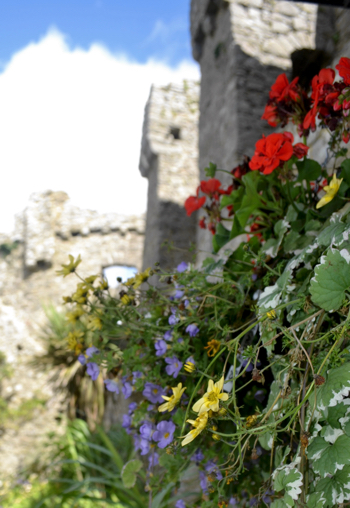 In fact, we’re here on a kind of pilgrimage. Last year, I’d come across a long-forgotten genealogy of my mother’s family, which traced our ancestors back to a Norman knight named Odo. A leader of William the Conqueror’s invasion of Wales, Odo had been rewarded in 1093 with huge estates along the Welsh coast, and made a Baron. He took the name “de Barri” from a nearby island, built a castle, and settled down to start a family.
In fact, we’re here on a kind of pilgrimage. Last year, I’d come across a long-forgotten genealogy of my mother’s family, which traced our ancestors back to a Norman knight named Odo. A leader of William the Conqueror’s invasion of Wales, Odo had been rewarded in 1093 with huge estates along the Welsh coast, and made a Baron. He took the name “de Barri” from a nearby island, built a castle, and settled down to start a family.
And that all led, some 900 years later, to this trip. For Odo de Barri, it turned out, was not only the builder of Manorbier Castle — he was also my 26th great-grandfather, and the man who gave my mother’s family, the Barrys, its name.
So, like anyone who discovers a castle in the family, we decided to go and have a look. And after tracking down the charming Dame Emily, who promptly offered to come meet us at Manorbier (from her, ahem, other castle, in Ireland), we flew to London at the end of June and caught the five-hour train to Tenby, a seaside town in the Welsh county of Pembrokeshire, just a few miles down the road.
To be honest, we’d never really paid much attention to Wales before this. Tucked between England and Ireland, the whole country is only about the size of Massachusetts, and doesn’t have much in the way of famous attractions. As far as we knew, Wales was equal parts coal mines, Dylan Thomas, and possibly sheep.
But as we waited for Naper to arrive in Pembrokeshire, we discovered that this southwest corner of Wales was both steeped in history and spectacularly beautiful. Surrounded on three sides by the ocean, it has what may be the most dramatic coastline in Britain, and if you’re ambitious enough you can hike its entire 186-mile length along the protected Pembrokeshire Coastal Path. Not being that ambitious, we tackled a significantly shorter stretch, but even that was unforgettable; it’s not for nothing that National Geographic ranks this as the second-best such path in the world. 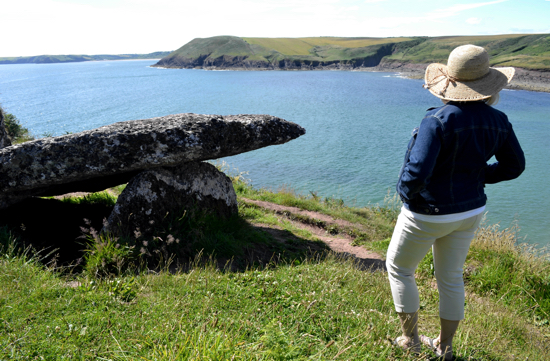
And if hiking’s not your thing, you can go whale-watching off the coast, inspect rare puffins in the wildlife preserves, or try the local sport of “coasteering,” which we were told (before we ran away, whimpering) involves helmets, wetsuits, and “flinging yourself from towering vertical rock faces."
Tenby itself, meanwhile, turned out to be a pleasantly old-fashioned seaside resort with cobblestone streets and pastel-colored Victorian houses, perched almost jauntily on a cliff over the ocean. With great restaurants and any number of sun-drenched cafes to choose from, we could have happily lazed away our week there doing pretty much nothing at all.
But we’d had the good fortune to meet one of the most intriguing people in Pembrokeshire. Marc Treanor, a fifty-something artist, philosopher and genial free spirit, makes a living carving vast geometric “sand circles” into the beaches of Wales. Intricate and immense — they can run fifty yards across— and not unlike crop circles, his creations can only be fully seen from above. And Tenby, with its high cliffside promenades looking down over flat sandy beaches, makes a near-perfect canvas.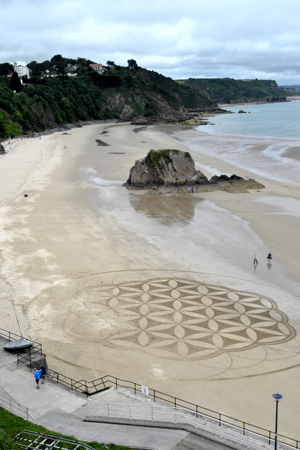 So we met up with Treanor on Tenby’s North Beach one gray afternoon for a private workshop, and for the next few hours — using only long wooden sticks, a ball of string, and a daunting amount of concentration — we drew a series of long, intersecting curves in the sand, darkening sections here and there with metal rakes. From ground level, it just looked like a lot of scratches. But we noticed that a crowd had gathered on the cliff above us, and when we finally put down our rakes and climbed up to join them, we saw what we’d created: a gigantic, mandala-like “flower of life” that seemed to blossom out of the sand. It felt like we had tattooed the world.
So we met up with Treanor on Tenby’s North Beach one gray afternoon for a private workshop, and for the next few hours — using only long wooden sticks, a ball of string, and a daunting amount of concentration — we drew a series of long, intersecting curves in the sand, darkening sections here and there with metal rakes. From ground level, it just looked like a lot of scratches. But we noticed that a crowd had gathered on the cliff above us, and when we finally put down our rakes and climbed up to join them, we saw what we’d created: a gigantic, mandala-like “flower of life” that seemed to blossom out of the sand. It felt like we had tattooed the world.
“Ah, but now comes the best part,” Treanor said, pointing out at the tide. “By tomorrow, it will have all washed away. It’s ephemeral. And that’s what makes it beautiful.”
That philosophy might, in a way, also apply to Wales’ main attraction: its ancient castles. There are some 600 of them scattered around the country — more than anywhere else in Europe — ranging from rudimentary earthworks to restored manor houses, and most have fallen into a state of picturesque, even poetic, decay. The remnants of Cilgerran Castle, for instance, are so mercilessly poignant that they were a tourist attraction way back in the 18th Century, and there are few sights as sigh-inducing as the elegant ruins of Carew Castle at sunset.
That poetry, though, tends to evaporate when you’re being guided around in a herd, and Pembrokeshire’s most famous castles — Carew, the historic fortress of Pembroke, the elegantly-preserved Picton and a few others — are fixtures on the well-worn tourist route, with hordes of visitors trudging through every day.
Those castles are still worth seeing, but it’s far more rewarding to get off the beaten track. So the next morning we navigated Pembrokeshire’s narrow lanes to a tiny, remote village by the sea, walked down a stately drive, crossed over a grassy, long-dry moat and found ourselves, quite alone, at the door of Manorbier Castle.
“Nobody knows we’re here!” Naper cheerfully greeted us, as she bustled around with her small staff, getting the place ready to open for the day. 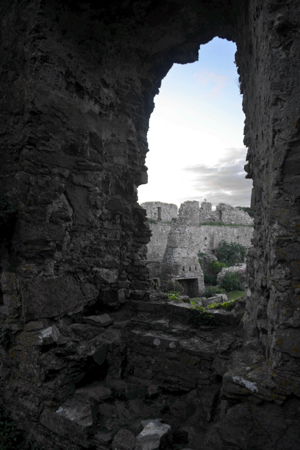 Given its beauty and spectacular setting, it’s odd that Manorbier has remained so overlooked. First built by Odo de Barri in earth and timber, the castle was rebuilt in stone by his son William around 1140 and expanded over the next two hundred years, to include a chapel, guard towers and barns within the high curtain walls, all of which remain. But after passing out of Barry hands in the 14th Century, Manorbier gradually declined, and by 1630 was being described as “ruynous.”
Given its beauty and spectacular setting, it’s odd that Manorbier has remained so overlooked. First built by Odo de Barri in earth and timber, the castle was rebuilt in stone by his son William around 1140 and expanded over the next two hundred years, to include a chapel, guard towers and barns within the high curtain walls, all of which remain. But after passing out of Barry hands in the 14th Century, Manorbier gradually declined, and by 1630 was being described as “ruynous.”
And little has changed since.
“It was like the Titanic when I first came here,” Naper told us, over a cup of tea in the courtyard. She’s made necessary repairs, cleaned up the gardens and and developed ways to boost income (castles are insatiable money pits), from opening a small cafe, to hosting weddings in the chapel, to presenting evenings of opera in the open courtyard. But she has little use for the guided tours and elaborate displays of her competitors, and Manorbier remains refreshingly low-key. Visitors can roam the castle freely on their own, soaking up the atmosphere and letting their imaginations be their guide.
And Manorbier has one more feature that, we were about to find, makes it perhaps the most distinctive anywhere. There’s an unobtrusive 19th Century cottage inside the castle walls which Naper rents it out by the week, and it’s usually booked years in advance. But the cottage had come open just as we arrived, and Naper, to our delight, told us we could take it for the night. We would have the entire castle to ourselves, she said, putting the key into my hand.
So after a stroll on the nearby beach and dinner in the village, we walked back to Manorbier in the summer twilight to reclaim, if only briefly, the long-lost Barry castle. And for the next few hours, as the shadows deepened around us, we wandered through the silent ruins alone. We sat in the huge, crumbling hall where my ancestors had lived their lives, lingered in the chapel where they had prayed, and climbed an ancient tower to look, as they would have, out over the darkening sea.
It was, as Naper had said, magical. And when the stars finally came out over the crenellated walls, we said goodnight to the ghosts we’d conjured up, took a last look around, and went into the cottage to dream.
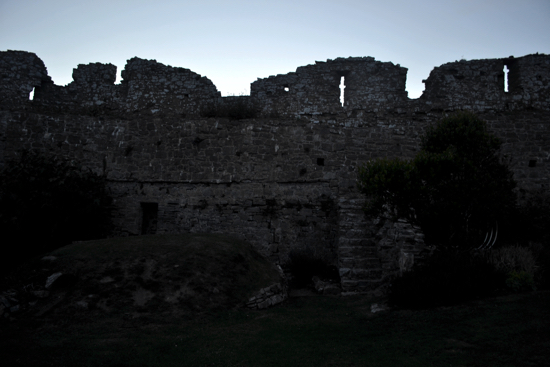
IF YOU GO:
GETTING THERE
Pembrokeshire is easy to get to from either England or Ireland, and Tenby is a perfect base for exploring. We took a circular route, flying into London and taking the five-hour train to Tenby the next day. We returned home via Dublin, taking the ferry from Pembroke to the Irish port of Rosslare, then a train north to the capital. Makes for a great trip.
London: The Arts Club
40 Dover Street, Mayfair London W1S 4NP
020 7499 8581
www.theartsclub.co.uk/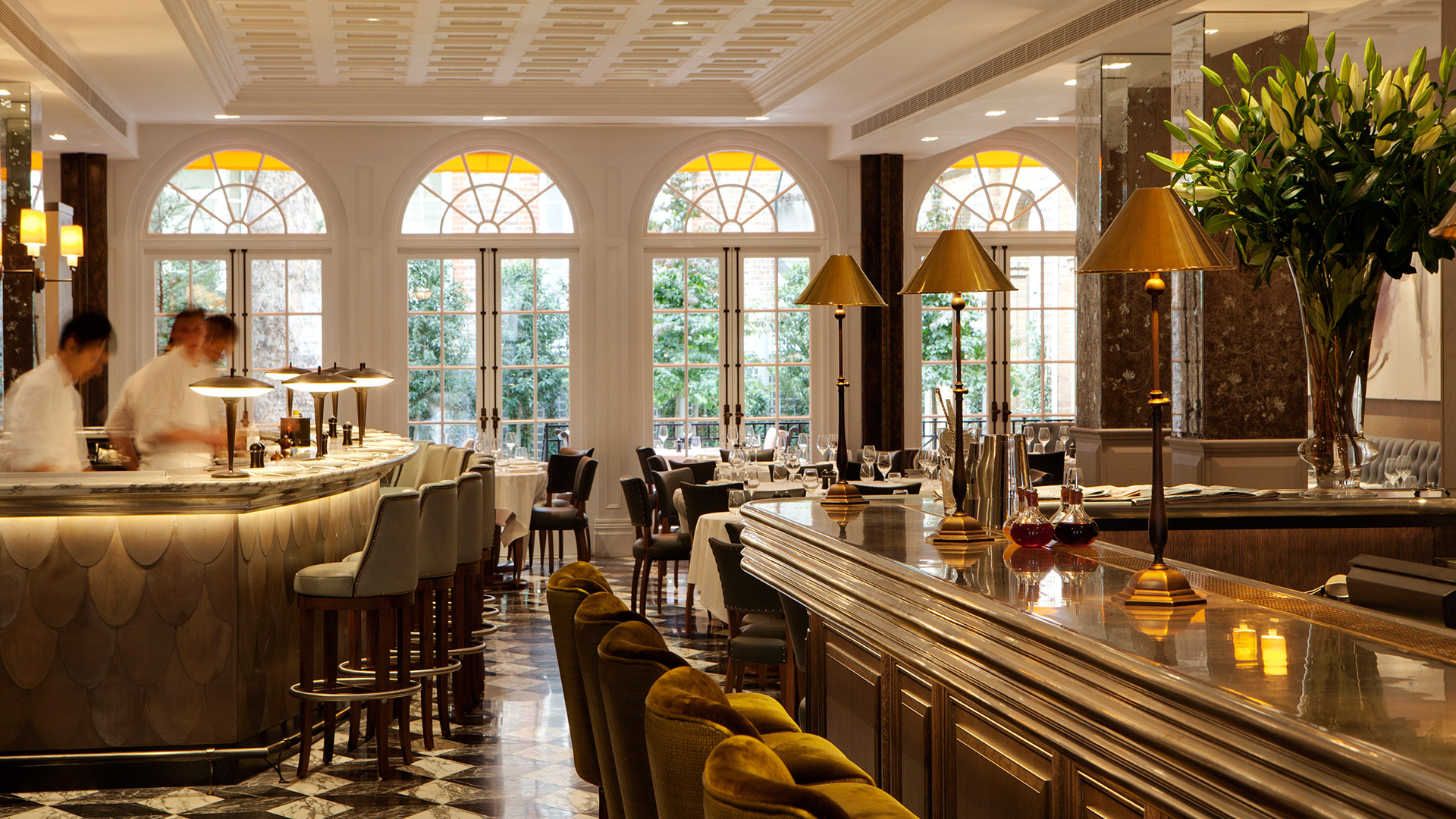 It's worth going to London just to stay at The Arts Club, in the heart of Mayfair Elegant, luxurious, and incredibly hip, this iconic club has been around since 1863, and a top-to-bottom renovation several years ago has made it perhaps the best hotel in town. Drinks in the courtyard and dinner at the superb Brasserie made for an unforgettable stay.
It's worth going to London just to stay at The Arts Club, in the heart of Mayfair Elegant, luxurious, and incredibly hip, this iconic club has been around since 1863, and a top-to-bottom renovation several years ago has made it perhaps the best hotel in town. Drinks in the courtyard and dinner at the superb Brasserie made for an unforgettable stay.
Dublin: The Westbury Hotel
Grafton Street, Dublin, Ireland
353 1 679 1122
www.doylecollection.com/hotels/the-westbury-hotel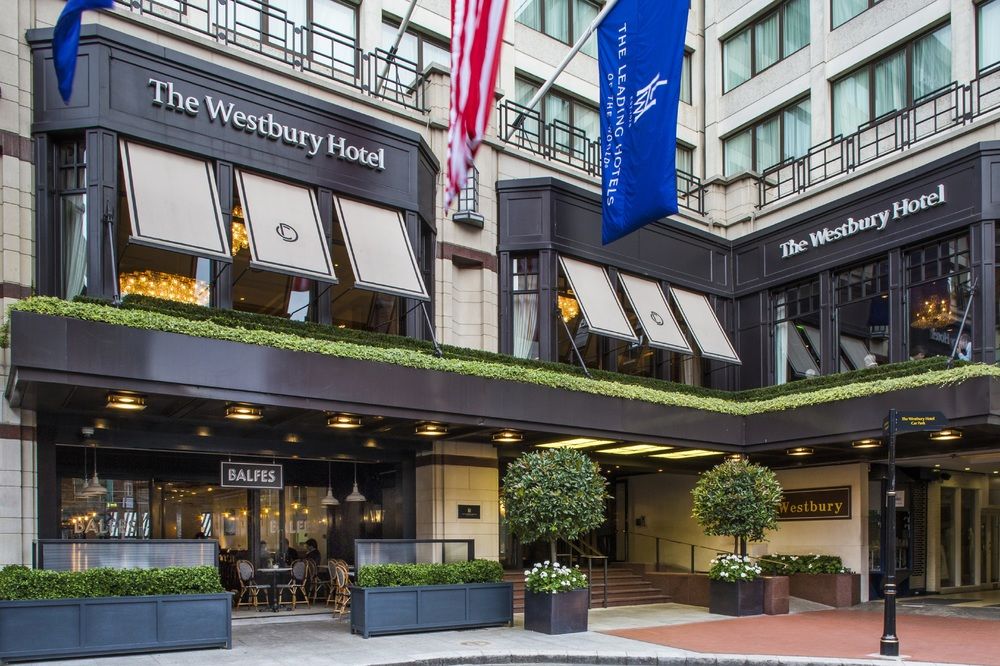 It was our first trip to Dublin, and the gorgeous, centrally-located Westbury Hotel, just off lively Grafton Street, was a perfect base for exploring the city.
It was our first trip to Dublin, and the gorgeous, centrally-located Westbury Hotel, just off lively Grafton Street, was a perfect base for exploring the city.
Both elegant and friendly, with a superb new restaurant called Wilde, the Westbury left little to be desired. Highly recommended.
IN WALES
The historic Welsh seaside resort of Tenby offers everything from surfing to whale-watching, or just strolling its ancient cobblestone lanes. Don’t expect fancy; Tenby is a relaxed, down-to-earth place with plenty of comfortable family hotels and great seafood. Great for families.
The Park Hotel
North Cliff, Tenby
South Pembrokeshire, SA70 8AT
+44 018 34 84 2480
www.parkhoteltenby.com/ We loved the old-fashioned Park Hotel, with its unbeatable views of Tenby. Set on a verdant cliff about a ten-minute walk from the town center, it’s comfortable and loaded with personality. Rooms run $160 to $250 in season.
We loved the old-fashioned Park Hotel, with its unbeatable views of Tenby. Set on a verdant cliff about a ten-minute walk from the town center, it’s comfortable and loaded with personality. Rooms run $160 to $250 in season.
Plantagenet House Restaurant
Quay Hill, Tudor Square, Tenby SA70 7BX
+44 01834 84 23 50
www.plantagenettenby.co.uk/
Housed in the oldest building in Tenby (parts of it date back to the 10th Century) Plantagenet House was a real find, with world-class cuisine and an old-world atmosphere. The imaginative, locally-sourced entrees run $26 to $50, with most starters about $10.
Caffè Vista
3 Crackwell Street, Tenby SA70 7HA
+44 1834 84 96 36
For coffee or light lunch with a great view over North Beach, this awesomely hip cafe is the place to hang out. Try the amazing cappuccino (about $3) and Greek lunch dishes ($10 to $16).
PLACES TO SEE
Pembrokshire’s medieval castles offer a compelling look into its fascinating, turbulent and romantic past. There are about a dozen of them within an hour of Tenby worth seeing, including:
Manorbier Castle
Manorbier, Tenby SA70 7SY
+44 1834 87 00 81
www.manorbiercastle.co.uk/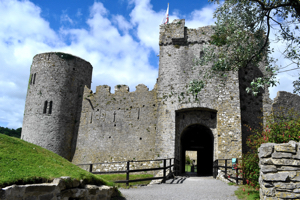 Manorbier Castle isn’t the biggest castle in Wales, but it may be the most captivating. Open daily from 10 am to 5 pm, March through October ($7.50 admission). Plan to spend a day there; after exploring the ruins, you can stroll down to the beach for a picnic, or hike the magnificent coastline. The 12th Century church of St. James and a neolithic stone tomb called the King’s Quoit are also within easy walking distance.
Manorbier Castle isn’t the biggest castle in Wales, but it may be the most captivating. Open daily from 10 am to 5 pm, March through October ($7.50 admission). Plan to spend a day there; after exploring the ruins, you can stroll down to the beach for a picnic, or hike the magnificent coastline. The 12th Century church of St. James and a neolithic stone tomb called the King’s Quoit are also within easy walking distance.
For a unique experience, stay in Manorbier’s fully-equipped cottage, which gives you the entire castle to yourself in the evening. It sleeps 12 and goes for $4,160 per week in the summer, and about half that in winter. But book early — it’s popular.
Pembroke Castle
Pembroke, Pembrokeshire, SA71 4LA
+44 01646 68 15 10
www.pembroke-castle.co.uk/pages/home
The most important castle in Pembrokeshire, Pembroke Castle is open year-round (summer hours 9:30 am to 5:30 pm, adult admission £6.60) and is heavy on exhibits, special events and re-enactments of medieval life. A great place to bring kids.
Picton Castle
Haverfordwest, Pembrokeshire SA62 4AS
+44 01437 75 13 26
www.pictoncastle.co.uk/
Open from mid-March through October (10 am to 5 pm, admission $12.50), the 12th Century Picton Castle is wonderfully well-preserved, and furnished with 18th Century antiques. It’s also home to one of the most beautiful gardens in Wales, a fine restaurant, and — awesomely — a world-class collection of antique lawnmowers.
Carew Castle
Carew, Tenby SA70 8SL
+44 1646 65 17 82
www.carewcastle.com
The 13th Century Carew Castle is a stunner, with a rich history and elegant setting — it’s built on the site of an Iron Age fort — and should be on everyone’s castle list. Open March to October, admission $7.00.
NON-CASTLE-Y THINGS TO DO
If you’re castled-out (it happens), hike at least some of the 186-mile Pembrokeshire Coastal Path for some fresh air and the most stunning views in Britain. Or drop by Tenby’s harbor to find a huge range of fun, affordable boat trips, including deep sea fishing, whale watching, and outings to nearby islands. The picturesque Cistercian monastery on Caldey Island is a popular destination for day-trippers.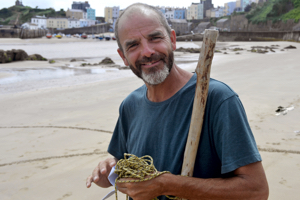 For a more offbeat experience, spend an afternoon with the artist Marc Treanor creating a mysterious “sand circle” on one of Pembrokeshire’s beaches. He’s great fun to hang out with, and offers private workshops tailored to your group. Contact him via his website, www.sandcircles.co.uk.
For a more offbeat experience, spend an afternoon with the artist Marc Treanor creating a mysterious “sand circle” on one of Pembrokeshire’s beaches. He’s great fun to hang out with, and offers private workshops tailored to your group. Contact him via his website, www.sandcircles.co.uk.
(This story also ran in The Philadephia Inquirer, the Austin American-Statesman, and several other papers.)


Reader Comments